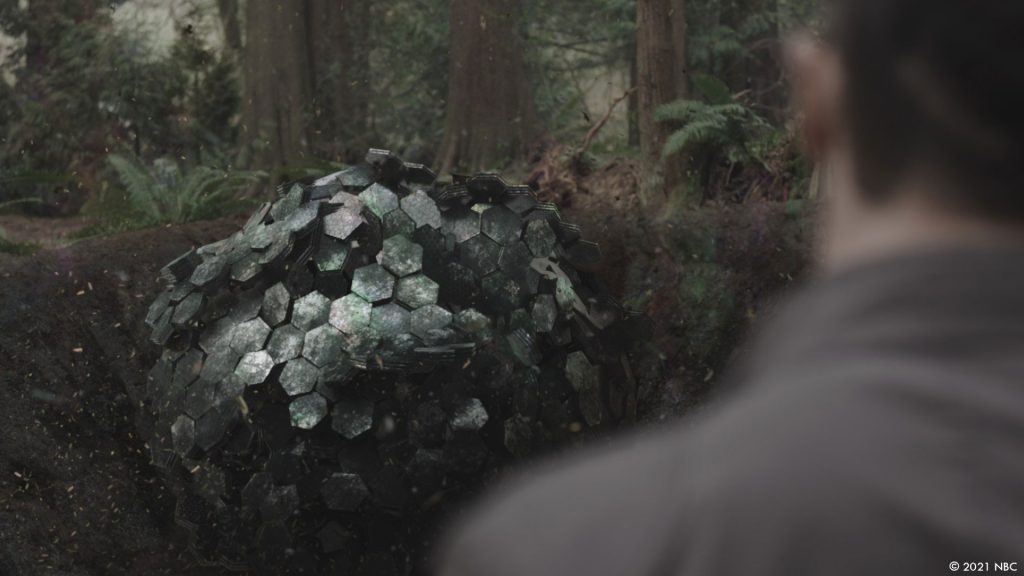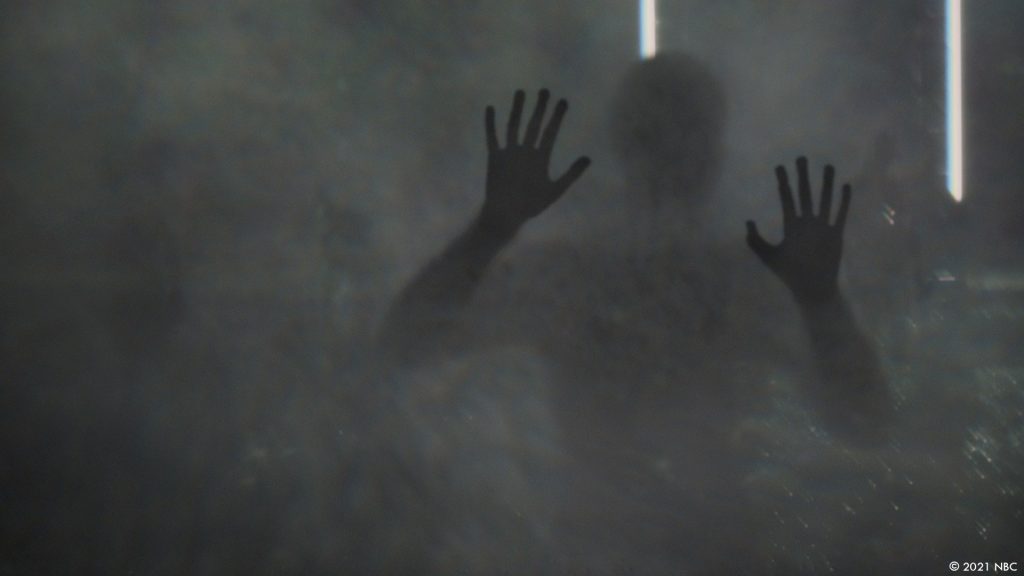Richard Greenwood has been working in visual effects for over 11 years. He joined FuseFX in 2014 to help launch the Vancouver office. He has worked on a wide range of projects including The Mist, Charmed, The Terror and The Magicians.
What is your background?
I have about 11 years VFX experience that’s split between pipeline, artist, and supervisor work, mostly in TV. FuseFX has played a strong role in my development with opportunities to grow on each project. Despite not going to school for VFX, I have been fortunate to benefit from some degrees in visual arts.
How did you and FuseFX get involved on this series?
We worked closely with the client side VFX, Jay Worth and Curtis Krick, for a number of years on The Magicians. We helped contribute to some of the work in the pilot in early development of Debris and when the show was picked up, we were fortunate to be able to continue that relationship.
How was the collaboration with the showrunners, directors and VFX Supervisors Jay Worth & Curtis Krick?
Jay was instrumental in helping us focus resources on the ship development. The first episode has design motifs that echo through the rest of the series, so it was crucial that we got it right. Most of the day-to-day interactions are with Curtis.
These two supervisors are a dream to work with. I don’t know how to say this without sounding like I’m buttering them up! The truth is that they understand the creative process and include us in shot design and production methodology discussions. They also understand the pressures of the industry and are friendly to work with.

What was his approach and expectations about the visual effects?
Ultimately our goals are unified to help service the story. As much as VFX contributes to the sci-fi genre, Debris is a human-interest story. There are quality expectations for photorealism of course, and the designs and execution must have visual impact.
How did you organize the work with your VFX Producer?
With the pilot and even with episodes, the tight turn-arounds require multiple streams of simultaneous Lookdev in order to deliver. Sometimes we’ll investigate 3D approaches in tandem with 2D or 2.5D solutions. We try to play to our team’s strengths to execute effectively. In many cases, this means trusting in our team’s expertise, giving them autonomy over their tasks and working backwards from our deliverable deadlines to figure out what’s possible within the scope of the shot.
How was the work split amongst the FuseFX offices?
The majority of the work is completed in BC with our Vancouver office with some concept and DMP supported out of our LA office.

How were the shots filmed where the people were literally flying over the ground?
In reference to the dust devil in the show, these are simpler than you might imagine with two different types of rig removal. The harness in each case did restrict the character’s movement, so we implemented some 2D animations to help them feel less rigid.
Can you explain in detail about your work when the heroes discovered a place where the bodies are spinning around?
We began by creating a clean plate with no characters, and one with characters without rigs. We tracked a 3D camera and match-moved all the characters with generic 3D models. Our FX team could then use the match-move as rough holdouts for the particle simulation.
We modelled some rough geo for grass, dirt and particulate to simulate into the dust devil and iterated through variants of quantity, density, speed and scale. Some of the design is motivated by the camera move and others by continuity. Using deep renders, our comp team layered all the clean plates, roto, FX elements and augmented character animation together.
What were the main challenges with these kinds of shots?
The natural visual chaos of the shot helps integration because it’s hard to read the layering without close examination. All in all, this sequence went smoothly. I think the most challenging aspect of the shot in the end was surprisingly not the FX. Animating the characters to feel less rigid took some iterations.
How did you create all the little elements that are floating over the bodies and in the forest?
We have two scenes with floating organic material. One was the dust devil mentioned above that used FX methodology. The other is over some Debris ship wreckage. For this sequence, we used 2D images instanced on particles that we rendered in Nuke.
What kind of references and influences did you receive to design and create the alien spaceship?
We received some early ship concept art from production. We built on top of this artwork with our own concepts that help drive much of the look. We couldn’t pull from reality too much, aside from texture reference, because the ship is intended to be otherworldly.
Can you elaborate about the creation of the wreckage of the alien spaceship and its larger version in the hangar?
Most wreckage of the alien spaceship begins as some form of concept art. The size and scope can sometimes be guided by the art department’s physical creation. We’ve had episodes in which we have recreated a CG version of the practical Debris piece, and others where we have entirely replaced it.
At the foundation of all the designs are some core principles: hexagons, precision and mystery.
In detail, the hexagon is a motif that shows up in almost every Debris piece we see. Its appearance mimics the self-similarity of fractal patterns. That is, we see it on a macro level in the wide angles of the ship reconstruction, at the micro level in the surface texture on the ship and as a component structure in between.
The hexagons in the ship needed to combine with a supernatural level of precision. We looked at how best to avoid an impression that the structure was human-made.
Lastly, we purposefully omitted sections of the ship, and of Debris wreckage in order to hide what the complete ship looks like. This is a story in which our protagonists need to be confronted with the unknown and we can mimic that sense of mystery in the reveal of the alien tech.

Can you tell us more about the shaders and textures work?
The shader and texture work completed on the pilot was admittedly completed in classic pilot style, a bit run-and-gun. Perfection is the enemy of done, so they say. It was a breath of fresh air when we had the opportunity to dive back in and spend the time required to get a higher quality.
I’m pleased to say that the pilot work conceptually was so strong that our project team could return to it for visual reference. Technically, the shader evolved to incorporate some of the successful forest lighting even when not in the same environment. As a metal surface, some of the brighter spec hits did provide some extra QC work on both the render front and the compositing side of things.

How did you extend the underground secret location?
We started with concept work to get a feel for the walls, ceiling, and layout. We kept getting bigger and bigger to help sell a sense of scale and awe. Much of the hangar architecture is designed to emphasize and highlight the Debris ship. There’s a lot of grey in the shots, and it was imperative that the ship stands out. The pilot shows Maddox driving through the Orbital hangar. These were full greenscreen shots. In some cases, we extended the camera move and in others, the practical move was enough.

Some of the bad guys can teleport themselves. Can you elaborate about the design and the creation of these effects?
We iterated through a number of different looks. Some had interactive light on the surrounding area, some had more intensity and others had different scales of noise at the leading edge. The design had to tell the story of the teleportation quickly, yet have an organic feel to them. To achieve this, a lot of time couldn’t be spent distorting the surrounding environment heavy-handedly. In the end, colour was one of the main directions after a successful buy off on speed and noise variation.
Can you tell us more about the motion design and holographic work?
We have one shot in the climax of episode 1 in which we see an Orbital scientist testing the Nacho as it gets close to the ship. We had some fun with this one. We were able to leverage some of the 3D builds for wireframe turntables.The main point behind the motion-graphic readouts is to inundate the audience with information.This has the benefit of visual complexity and helps the sci-fi feel immensely.

Did you want to reveal any other invisible effects?
There’s some CCTV footage of the maid as she hits the table after falling 14 stories.
This was a full CG digi-double build, complete with rigging, animation, FX integration. We stopped just shy of cloth simulation here, getting away with blend shapes and 2D animated warps. The shot goes by quickly, but it’s so visceral and successful because of it!
Is there something specific that gives you some really short nights?
I can credit our production team here for doing an excellent job planning, our Comp and CG supervisors for executing methodologies effectively and our artists for their time and inspiration. Without these key roles and their commitment to excellence, I imagine we would have had more long days.

What is your favorite shot or sequence?
Debris has favoured us with some wonderful opportunities to showcase some beautiful VFX. Our dimensional window in episode 3 is one of my favourites, but it’s a close contender with our ship and hangar work.
What is your best memory on this show?
Showcasing our team’s amazing work has been a privilege and will remain my best memory.
How long have you worked on this show?
I’ve worked on this show since March of 2020.
What’s the VFX shots count?
It varies of course but we’ve contributed anywhere from 30 shots to 120 on any one episode.
What was the size of your team?
At our largest, we had a team of about 10 3D artists (trackers, modellers, animators, lighters) and 10 2D artists (concept, DMP, compers). But there are so many others behind the scenes, from IT, to editorial, to production management who all have an important role to play in getting this show done.

What is your next project?
Not sure at the moment, but in TV, there’s always something coming up fast.
What are the four movies that gave you the passion for cinema?
In terms of VFX, Jurassic Park still astonishes me today, but in terms of my formative years, you can pick any Spielberg film.
In terms of scope, Christopher Nolan’s work is always inspirational, so let’s take Interstellar. Peter Jackson’s Lord of the Rings was ground-breaking as well.
Lastly, I want to include something from before I was around, Chris Marker’s La Jetée, as a reminder of the simplicity of great storytelling.
A big thanks for your time.
// Debris – VFX Breakdown – FuseFX
WANT TO KNOW MORE?
NBC: You can now watch Debris on NBC.
© Vincent Frei – The Art of VFX – 2021




